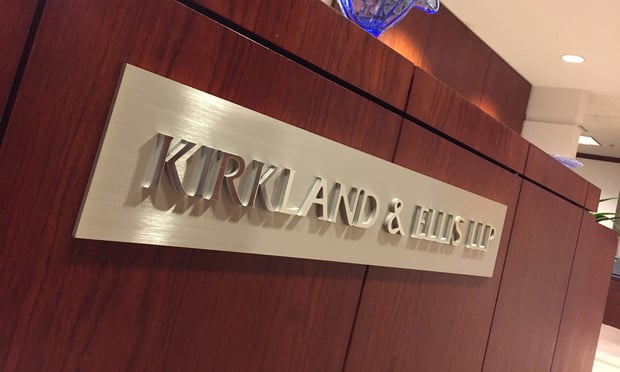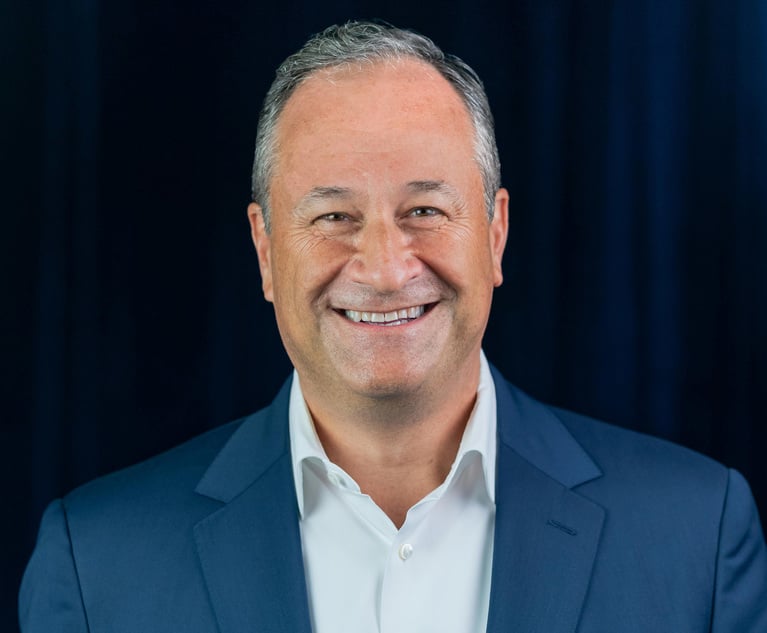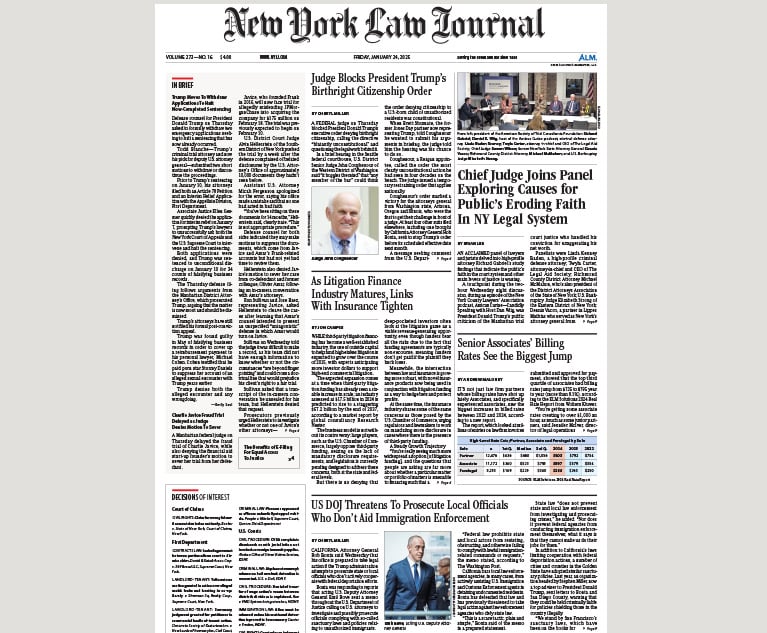Kirkland Poised to Keep Title as Largest Law Firm in the U.S.
Kirkland & Ellis added $592 million in revenue to its top line, or about the size of the 61st largest law firm in the U.S. last year.
March 21, 2019 at 02:55 PM
6 minute read
The original version of this story was published on The American Lawyer

Kirkland & Ellis looks likely to retain its title as the largest law firm in the U.S. by revenue after a year in which the Chicago-founded firm grew its top line more than 18 percent to $3.76 billion and its profits per equity partner topped $5 million for the first time, according to preliminary ALM data.
The firm's financial growth was propelled by a 15 percent head count increase, adding more than 300 lawyers to 2,306. Kirkland last July opened an office in Dallas, where the firm now has nearly 40 lawyers.
Despite the head count growth, Kirkland was able to increase its lawyers' financial productivity, boosting revenue per lawyer by about 2.8 percent to $1.63 million. Kirkland's average profits per equity partner came in at $5,037,000, up about 7 percent from $4.7 million a year ago.
Kirkland's PEP slightly surpasses Paul Weiss' new $5.02 million profits per partner figure and brings Kirkland closer to Wachtell, Lipton, Rosen & Katz, whose 2017 figure was pegged at $5.7 million.
The firm's revenue increased in aggregate by $592 million from 2017, or about the size of the 61st largest firm by revenue in last year's Am Law 100, Pillsbury Winthrop Shaw Pittman. Over the past two years, the firm's top line has grown by more than $1 billion.
Kirkland last year overtook Latham & Watkins as the world's largest firm by revenue, and once again outperformed Latham, which last year saw revenue grow to $3.39 billion.
Kirkland declined to comment on its finances.
In the post-recession years, Kirkland has experienced an unprecedented growth spurt fueled largely by investing in highly paid talent in some of the least price-sensitive legal businesses: Private equity deals, big-ticket public mergers and high-stakes litigation reaching all the way to the U.S. Supreme Court. The firm's 2018 results mark the third straight year of revenue growth of 15 percent or more at Kirkland.
The firm is undergoing a leadership transition, with longtime chairman Jeff Hammes being replaced in 2020 by fellow private equity partner Jon Ballis. That transition has caused some to question whether Kirkland's lateral hiring spree can continue. Hammes' legacy includes shaping a firm with a 15-member management committee comprised of no fewer than six laterals, Ballis included.
As that transition plays out, the firm's private equity business continued to be its main driver of financial growth in 2018.
Kirkland benefited from a red-hot buyout business that last year reached its highest levels of deal value in a decade, $556 billion, according to Mergermarket, which tracks M&A deals. The total number of private equity buyouts in 2018—3,599—set a record, as did the number of private equity exits, by Mergermarket's count.
Kirkland handled 330 private equity deals last year, nearly double the next most active firm by deal count, Goodwin Procter, according to Mergermarket. Kirkland's total deal count, including public M&A, was also the highest in Mergermarket's standings, at 568 global deals. Latham & Watkins, by comparison, handled 360 deals, according to Mergermarket.
The firm's high deal count relative to other firms is largely a function of its practice taking root with middle-market funds. But in recent years, it has made inroads at some of the largest buyout shops, including The Blackstone Group, Bain Capital and Vista Equity Partners. Kirkland announced it represented Blackstone in more than 10 published deals last year; advised Bain on more than 15 and Vista on over 20.
The firm last year continued to invest in its private equity practice, hiring more than 20 laterals in the buyout business that were often in leadership roles at competitor firms.
Those lawyers included the former co-chairwoman of Latham & Watkins' global private equity practice, Jennifer Perkins; Latham's Houston-based oil and gas corporate leader, Sean Wheeler; Freshfields' London-based former co-head of global financial investors sector group David Higgins; and Ken Muller, the former co-chairman of Morrison & Foerster's private equity funds and buyout group, based in San Francisco.
Some of Kirkland's most notable public M&A deals in 2018 included representing Bristol-Myers Squibb Co. on its $90 billion agreement to acquire Celgene Corp.; advising Danaher Corp. in its $21.4 billion agreement to acquire the biopharma division of GE Life Sciences; and global drilling services provider Rowan Companies plc in its $12 billion combination with Ensco plc.
Kirkland's litigation practice also had a strong year, winning six cases at the nation's high court in 2018. That success is thanks to a practice in large part driven by Paul Clement, the former U.S. solicitor general whose practice Kirkland acquired with the 2016 merger of his boutique, Bancroft.
The firm also secured a victory for Johnson & Johnson in a talc-related mesothelioma case in California; beat back a $1 billion-plus claim in a trade secrets case on behalf of Flexus Biosciences, a Bristol-Myers Squibb subsidiary; and helped Teva Pharmaceutical Industries enforce a $125 million settlement agreement against insurer United Healthcare. The firm has said its intellectual property litigation practice secured 53 wins in 2018 at the U.S. Patent and Trademark Office, an increasingly important aspect of IP litigation.
Kirkland also made waves in 2018 with the hire of former Cravath Swaine & Moore litigation head Sandra Goldstein, who the New York Times reported has an annual of salary of $11 million. She has been busy since joining Kirkland in April. This month, Goldstein won a case for Barnes & Noble in the U.S. Court of Appeals for the Second Circuit, saving the retailer potentially hundreds of millions of dollars for purported violations of its users' privacy.
The firm's success this year puts the $4 billion revenue barrier within its sights for next year. That barrier would require revenue growth next year of about 6.5 percent, or less than half what the firm has accomplished in each of the three previous years.
This content has been archived. It is available through our partners, LexisNexis® and Bloomberg Law.
To view this content, please continue to their sites.
Not a Lexis Subscriber?
Subscribe Now
Not a Bloomberg Law Subscriber?
Subscribe Now
NOT FOR REPRINT
© 2025 ALM Global, LLC, All Rights Reserved. Request academic re-use from www.copyright.com. All other uses, submit a request to [email protected]. For more information visit Asset & Logo Licensing.
You Might Like
View All

Deal Watch: Deals, IPOs Flow as Banking Regulation Is Expected to Get Lighter
11 minute readTrending Stories
- 1Adding 'Credibility' to the Pitch: The Cross-Selling Work After Mergers, Office Openings
- 2Low-Speed Electric Scooters and PIP, Not Perfect Together
- 3Key Updates for Annual Reports on Form 10-K for Public Companies
- 4When Words Matter: Mastering Interpretation in Complex Disputes
- 5People in the News—Jan. 28, 2025—Buchanan Ingersoll, Kleinbard
Featured Firms
Law Offices of Gary Martin Hays & Associates, P.C.
(470) 294-1674
Law Offices of Mark E. Salomone
(857) 444-6468
Smith & Hassler
(713) 739-1250








